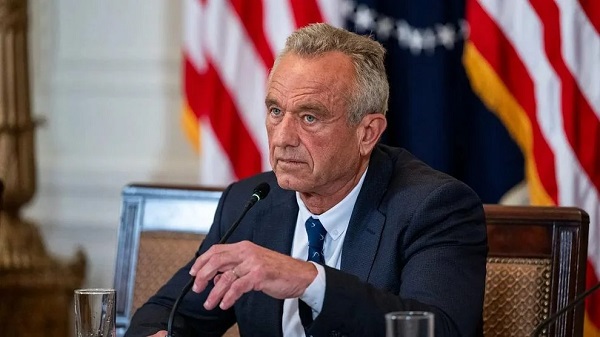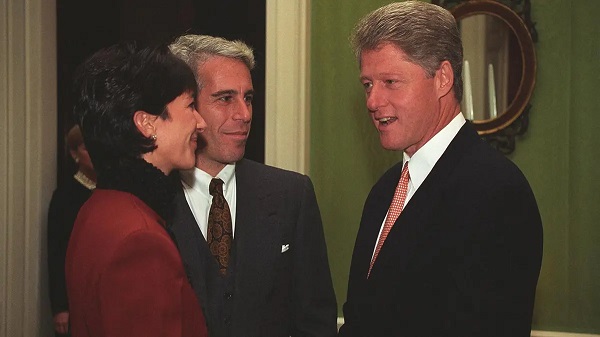Alberta
Montreal urban fish farmers say their Arctic char cuts greenhouse gases and waste
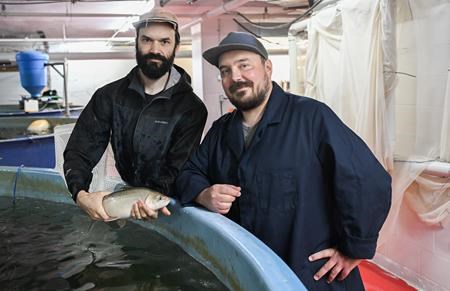
MONTREAL — A warehouse basement in an industrial area of Montreal, near the intersection of two highways, feels about as far from a fish habitat as it gets.
But walk through the doors of Opercule’s self-described “urban fish farm,” and the unmistakable smell of fish fills the air.
After donning rubber boots and lab coats, visitors are greeted with the constant hum of the plant’s filtration system. Inside the dimly lit warehouse basement, thousands of sleek, speckled Arctic char swim in a dozen or so round pools, their fins smoothly breaking the surface or sending up alarmed splashes as they scurry away from people who approach the tanks.
The business is the creation of David Dupaul-Chicoine and Nicolas Paquin, who met each other when they were studying aquaculture in college on Quebec’s Gaspé Peninsula. What began as an experiment raising fish in Dupaul-Chicoine’s garage has turned into a commercial operation that they expect will soon produce between 25 and 30 tonnes of Arctic char per year.
By raising fish on land and in an urban setting, Dupaul-Chicoine and Paquin say they hope to avoid some of the problems associated with open net fish farms, which are suspected by some conservationists of harming wild stock by spreading disease or parasites, or by escaping and interbreeding with them.
“We’re not trying to prove anything, but we’re trying to do things the way we think they should be done,” Dupaul-Chicoine said. “We’re raising fish to sell them and we’re thinking about every little step in the production. The way we deliver, the way everything is done, we try to do it in a more eco-friendly way.”
The business uses a recirculation system that filters ammonia and carbon dioxide from water, which is then reinjected with oxygen and pumped back to the tanks — vastly reducing water use. Their city setting cuts greenhouse gas emissions, as deliveries to restaurants can be done on electric bicycles. As well, they only kill fish once the animals are ordered, reducing waste. They’ve even replaced Styrofoam delivery containers with insulated cardboard, they say.
Arctic char was chosen because it sells for a good price and the animals stay healthy in close quarters.
The only downside on the environmental front, they say, is that the fish plant uses “a lot” of electricity. Their business model, Dupaul-Chicoine said, probably wouldn’t make sense if it ran on coal; luckily for them, however, Quebec has ample cheap and relatively clean hydropower.
The pair say their biggest challenge was obtaining the necessary permits — a process that took them about two years after they started their business in 2019. Because it takes 15 or 16 months for a fish to grow from an egg to market size, their first sales only came at the start of 2023.
An indoor filtration system like theirs also needs maintenance and a constant stream of electricity. Among their most stressful moments was a two-day power outage during an ice storm earlier this year; they worried that their generator would go down and cause them to lose fish.
“You have to make sure you have backups, and backups of the backups,” Dupaul-Chicoine said.
Grant Vandenberg, an aquaculture specialist at Université Laval’s agriculture and food sciences department, says land-based water-recirculation farms have some advantages over net pen farms — which are enclosed cages that float in natural water sources. Land farms eliminate concerns over environmental interactions between wild and farmed fish, and waste is easier to collect and can even be recycled into fertilizer for plants, he said.
However, land-based farms are more expensive to start and operate, and require more labour, machinery and energy than do net pens, Vandenberg said. “I think it would be very difficult for some to be able to compete economically,” he said, noting that consumers have the option to purchase imported fish produced cheaper in other countries or provinces.
Vandenberg said that despite the controversies, fish farming has an important role to play in preventing overfishing of wild stocks. Improving fish-farming technology, he added, is reducing the industry’s environmental impact.
Just as agriculture has largely replaced hunting when it comes to meat, “we have to stop hunting fish as well, and I think the answer is to produce them,” he said.
Fish farming will also improve food sovereignty, Vandenberg said, noting that Quebec — which doesn’t use open-water net pens — produces only seven per cent of the trout it consumes. He said Paquin and Dupaul-Chicoine’s operation in Montreal presents an interesting model because the plant’s proximity to its market reduces shipping costs and ensures fresher fish.
Dupaul-Chicoine and Paquin said it cost about a million dollars to launch their fish farm, which includes a processing facility, and they admit it wouldn’t have been possible without provincial government grants. However, they said they’re pleased with early sales, noting they recently passed the break-even point in terms of operational profitability.
Both said that, so far, they have no regrets. “Before this I had a career as a mechanical engineer and I decided I wanted a change,” Paquin said. “So for me, it’s fun, even though it’s hard.”
Once they’ve proved to investors and themselves that their business model can be successful, they’re hoping to expand into a bigger facility.
This report by The Canadian Press was first published Aug. 13, 2023.
Morgan Lowrie, The Canadian Press
Alberta
Ottawa-Alberta agreement may produce oligopoly in the oilsands

From the Fraser Institute
By Jason Clemens and Elmira Aliakbari
The federal and Alberta governments recently jointly released the details of a memorandum of understanding (MOU), which lays the groundwork for potentially significant energy infrastructure including an oil pipeline from Alberta to the west coast that would provide access to Asia and other international markets. While an improvement on the status quo, the MOU’s ambiguity risks creating an oligopoly.
An oligopoly is basically a monopoly but with multiple firms instead of a single firm. It’s a market with limited competition where a few firms dominate the entire market, and it’s something economists and policymakers worry about because it results in higher prices, less innovation, lower investment and/or less quality. Indeed, the federal government has an entire agency charged with worrying about limits to competition.
There are a number of aspects of the MOU where it’s not sufficiently clear what Ottawa and Alberta are agreeing to, so it’s easy to envision a situation where a few large firms come to dominate the oilsands.
Consider the clear connection in the MOU between the development and progress of Pathways, which is a large-scale carbon capture project, and the development of a bitumen pipeline to the west coast. The MOU explicitly links increased production of both oil and gas (“while simultaneously reaching carbon neutrality”) with projects such as Pathways. Currently, Pathways involves five of Canada’s largest oilsands producers: Canadian Natural, Cenovus, ConocoPhillips Canada, Imperial and Suncor.
What’s not clear is whether only these firms, or perhaps companies linked with Pathways in the future, will have access to the new pipeline. Similarly, only the firms with access to the new west coast pipeline would have access to the new proposed deep-water port, allowing access to Asian markets and likely higher prices for exports. Ottawa went so far as to open the door to “appropriate adjustment(s)” to the oil tanker ban (C-48), which prevents oil tankers from docking at Canadian ports on the west coast.
One of the many challenges with an oligopoly is that it prevents new entrants and entrepreneurs from challenging the existing firms with new technologies, new approaches and new techniques. This entrepreneurial process, rooted in innovation, is at the core of our economic growth and progress over time. The MOU, though not designed to do this, could prevent such startups from challenging the existing big players because they could face a litany of restrictive anti-development regulations introduced during the Trudeau era that have not been reformed or changed since the new Carney government took office.
And this is not to criticize or blame the companies involved in Pathways. They’re acting in the interests of their customers, staff, investors and local communities by finding a way to expand their production and sales. The fault lies with governments that were not sufficiently clear in the MOU on issues such as access to the new pipeline.
And it’s also worth noting that all of this is predicated on an assumption that Alberta can achieve the many conditions included in the MOU, some of which are fairly difficult. Indeed, the nature of the MOU’s conditions has already led some to suggest that it’s window dressing for the federal government to avoid outright denying a west coast pipeline and instead shift the blame for failure to the Smith government.
Assuming Alberta can clear the MOU’s various hurdles and achieve the development of a west coast pipeline, it will certainly benefit the province and the country more broadly to diversify the export markets for one of our most important export products. However, the agreement is far from ideal and could impose much larger-than-needed costs on the economy if it leads to an oligopoly. At the very least we should be aware of these risks as we progress.

Elmira Aliakbari
Alberta
A Christmas wish list for health-care reform
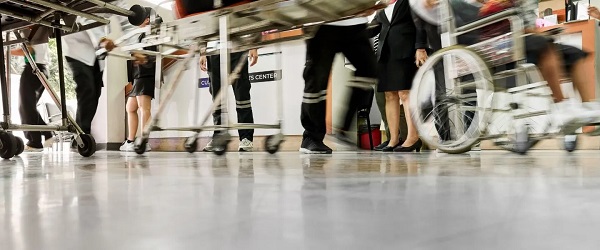
From the Fraser Institute
By Nadeem Esmail and Mackenzie Moir
It’s an exciting time in Canadian health-care policy. But even the slew of new reforms in Alberta only go part of the way to using all the policy tools employed by high performing universal health-care systems.
For 2026, for the sake of Canadian patients, let’s hope Alberta stays the path on changes to how hospitals are paid and allowing some private purchases of health care, and that other provinces start to catch up.
While Alberta’s new reforms were welcome news this year, it’s clear Canada’s health-care system continued to struggle. Canadians were reminded by our annual comparison of health care systems that they pay for one of the developed world’s most expensive universal health-care systems, yet have some of the fewest physicians and hospital beds, while waiting in some of the longest queues.
And speaking of queues, wait times across Canada for non-emergency care reached the second-highest level ever measured at 28.6 weeks from general practitioner referral to actual treatment. That’s more than triple the wait of the early 1990s despite decades of government promises and spending commitments. Other work found that at least 23,746 patients died while waiting for care, and nearly 1.3 million Canadians left our overcrowded emergency rooms without being treated.
At least one province has shown a genuine willingness to do something about these problems.
The Smith government in Alberta announced early in the year that it would move towards paying hospitals per-patient treated as opposed to a fixed annual budget, a policy approach that Quebec has been working on for years. Albertans will also soon be able purchase, at least in a limited way, some diagnostic and surgical services for themselves, which is again already possible in Quebec. Alberta has also gone a step further by allowing physicians to work in both public and private settings.
While controversial in Canada, these approaches simply mirror what is being done in all of the developed world’s top-performing universal health-care systems. Australia, the Netherlands, Germany and Switzerland all pay their hospitals per patient treated, and allow patients the opportunity to purchase care privately if they wish. They all also have better and faster universally accessible health care than Canada’s provinces provide, while spending a little more (Switzerland) or less (Australia, Germany, the Netherlands) than we do.
While these reforms are clearly a step in the right direction, there’s more to be done.
Even if we include Alberta’s reforms, these countries still do some very important things differently.
Critically, all of these countries expect patients to pay a small amount for their universally accessible services. The reasoning is straightforward: we all spend our own money more carefully than we spend someone else’s, and patients will make more informed decisions about when and where it’s best to access the health-care system when they have to pay a little out of pocket.
The evidence around this policy is clear—with appropriate safeguards to protect the very ill and exemptions for lower-income and other vulnerable populations, the demand for outpatient healthcare services falls, reducing delays and freeing up resources for others.
Charging patients even small amounts for care would of course violate the Canada Health Act, but it would also emulate the approach of 100 per cent of the developed world’s top-performing health-care systems. In this case, violating outdated federal policy means better universal health care for Canadians.
These top-performing countries also see the private sector and innovative entrepreneurs as partners in delivering universal health care. A relationship that is far different from the limited individual contracts some provinces have with private clinics and surgical centres to provide care in Canada. In these other countries, even full-service hospitals are operated by private providers. Importantly, partnering with innovative private providers, even hospitals, to deliver universal health care does not violate the Canada Health Act.
So, while Alberta has made strides this past year moving towards the well-established higher performance policy approach followed elsewhere, the Smith government remains at least a couple steps short of truly adopting a more Australian or European approach for health care. And other provinces have yet to even get to where Alberta will soon be.
Let’s hope in 2026 that Alberta keeps moving towards a truly world class universal health-care experience for patients, and that the other provinces catch up.
-

 Business2 days ago
Business2 days agoSome Of The Wackiest Things Featured In Rand Paul’s New Report Alleging $1,639,135,969,608 In Gov’t Waste
-

 Energy2 days ago
Energy2 days ago‘The electric story is over’
-

 Alberta1 day ago
Alberta1 day agoOttawa-Alberta agreement may produce oligopoly in the oilsands
-

 Energy1 day ago
Energy1 day agoWestern Canada’s supply chain for Santa Claus
-
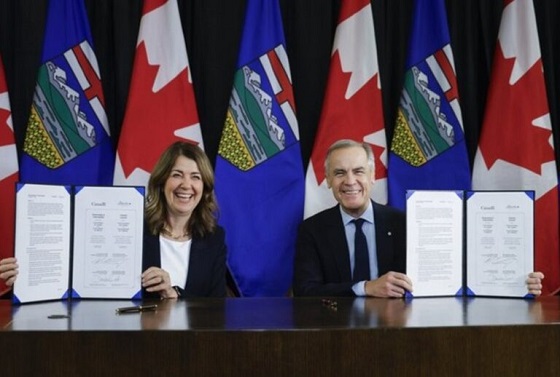
 Energy1 day ago
Energy1 day agoThe Top News Stories That Shaped Canadian Energy in 2025 and Will Continue to Shape Canadian Energy in 2026
-

 International1 day ago
International1 day ago$2.6 million raised for man who wrestled shotgun from Bondi Beach terrorist
-

 armed forces12 hours ago
armed forces12 hours agoRemembering Afghanistan and the sacrifices of our military families
-

 Fraser Institute11 hours ago
Fraser Institute11 hours agoHow to talk about housing at the holiday dinner table






